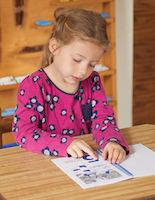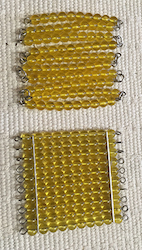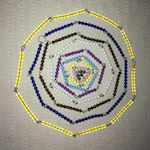
"We have to let children experience the beauty of arithmetic... it is always something to discover and to perceive by the hand before being understood by the mind."
—Philip D. O'Brien, from the introduction to Psychoarithmetic by Maria Montessori
 Mathematics comes naturally to children precisely because the world they live in is mathematical. It is a world of order: quantity, space, succession, and form are all mathematical concepts. For some adults, math was their least favorite subject in school, especially if the emphasis was on memorization. Many of us discovered in our Montessori teacher-training an excitement and joy for the subject, as we were finally able to understand math in a more meaningful way. As Alice Waters, founder of the Edible Schoolyard and Chez Panisse restaurant, reflected, "I could never, ever do math, and all of a sudden in my [Montessori] training I was doing fractions!" (Keynote Address, AMI Refresher Course, 2018)
Mathematics comes naturally to children precisely because the world they live in is mathematical. It is a world of order: quantity, space, succession, and form are all mathematical concepts. For some adults, math was their least favorite subject in school, especially if the emphasis was on memorization. Many of us discovered in our Montessori teacher-training an excitement and joy for the subject, as we were finally able to understand math in a more meaningful way. As Alice Waters, founder of the Edible Schoolyard and Chez Panisse restaurant, reflected, "I could never, ever do math, and all of a sudden in my [Montessori] training I was doing fractions!" (Keynote Address, AMI Refresher Course, 2018)
Montessori education is famous for its ingenious, multi-sensory materials which gradually introduce children to more and more complex concepts. Because the materials allow for self-monitoring and self-correction, instruction is minimal. Rather than listening to a teacher explain concepts, children manipulate the materials and make their own discoveries. Using Montessori math materials, children wire their brains "for higher thinking, creative problem-solving, and for logical processing of information." (Michael Duffy, Math Works)
Both the Practical Life and Sensorial curriculums play an essential role in indirectly preparing the child's mathematical mind. Practical Life helps children to order their minds by presenting activities with sequential and logical step-by-step precision.
Sensorial materials help to bring order to the many sense impressions in a child's world. As they explore and manipulate the concrete materials, children's powers of observation, judgment, and reason develop. Mathematical concepts are unconsciously absorbed. Working with materials such as the Pink Tower, Brown Stair, and Red Rods, children attend to dimension and learn to recognize similarities, differences, and gradations in size, width, weight, and length.
When children learn to count, they may be able to recite numbers, but understanding number-quantity correspondence is an abstraction that comes at another stage of development. Many of the ingenious Montessori math materials help children develop this link.
By working with the Spindle Boxes, children count and see the difference between one spindle and nine. Montessori education is unique in introducing the concept of zero to young children. They can see and feel that there is nothing in the Spindle Box compartment labeled "0". Children delight in learning that the number zero - a numeral like the others - means "nothing." I was told in my training that Maria Montessori reinforced this concept by asking the children to "blow her zero kisses."
When children play the Bank Game, they feel how much heavier their tray is when they fetch a higher number with more hundred squares and thousand cubes. Laying out and then walking the length of the Thousand Chain in a long hallway, children experience firsthand the astonishing length of the quantity of 1000 beads.
As children progress through the mathematical materials, they are gradually set free of the material. "When they leave the material, the children very easily reach the point where they wish to write out the operation... and acquire a kind of natural and spontaneous inclination for mental calculations." (Maria Montessori, Discovery of the Child)
Many Montessori teachers have had "aha" moments in their training when the math they memorized as children suddenly makes sense. One teacher realized with astonishment, as she worked with the Bead Chain cabinet, that a number squared actually forms a square and that a number cubed forms a cube that you can hold in your hand.
 The materials of the Bead Cabinet are well-known for teaching linear counting and skip counting. They can also be explored in a purely sensorial way, helping children discover a variety of mathematical concepts. You can show children how to:
The materials of the Bead Cabinet are well-known for teaching linear counting and skip counting. They can also be explored in a purely sensorial way, helping children discover a variety of mathematical concepts. You can show children how to:
 take all of the squaring chains to a rug and explore the geometric shapes they can make. The one chain is a point; the two chain forms an angle; the three, a triangle; the four, a quadrilateral; the five, a pentagon; the six, a hexagon; the seven, a septagon; the eight, an octagon; the nine, a nonagon; and the ten, a decagon. It's especially beautiful to place the next largest chain around the shape made by the previous one.
take all of the squaring chains to a rug and explore the geometric shapes they can make. The one chain is a point; the two chain forms an angle; the three, a triangle; the four, a quadrilateral; the five, a pentagon; the six, a hexagon; the seven, a septagon; the eight, an octagon; the nine, a nonagon; and the ten, a decagon. It's especially beautiful to place the next largest chain around the shape made by the previous one.The focus in Montessori math education is not on getting the right answer, but rather on the process of how an answer is reached and what is discovered along the way. Children who have worked sensorially with the Binomial and Trinomial Cubes in the primary classroom can discover, as elementary students, the algebraic formula for finding the volume of those cubes. Imagine sitting for your SAT test and seeing the Trinomial Cube in your mind, rather than hoping to recall a memorized formula!
In a pamphlet jokingly titled, "Those Horrible Mathematics, " Mario Montessori described a class of 9-12 year-olds whose "enthusiasm had become a flood" as they discovered mathematical patterns while calculating squares and cubes of numbers. More children joined in, helping glue 32 feet of paper together to record their calculations and newly discovered algebraic formulations. Their teacher reported, "Though the quantity of the paper consumed was enormous, the happiness derived from the work was in proportion, if not raised to the second or third power."
As primary teachers, we help children lay the foundation for these future discoveries and higher learning. When young children explore and manipulate the Montessori materials, they build their mathematical minds and begin a lifelong passion for learning.
"...the absorption of mathematical knowledge can be natural, easy, and a source of joy; the joy of one who discovers in himself powers that he had not even suspected."
—Mario Montessori, Maria Montessori's Contribution to the Cultivation of the Mathematical Mind
—by Irene Baker, MEd, Montessori Educational Consultant at Montessori Services. She holds both primary (ages 3-6) and elementary (ages 6-12) Montessori certifications and has taught at all three levels. For over 20 years, she has served as a Montessori consultant and teacher-trainer for primary and elementary levels, and has presented workshops for teachers at schools and AMS conferences. Her work with students and teachers is infused with her passions: storytelling, history, social justice, non-violent (compassionate) communication, poetry, meditation, music, and the natural world.
—Originally Published 2018